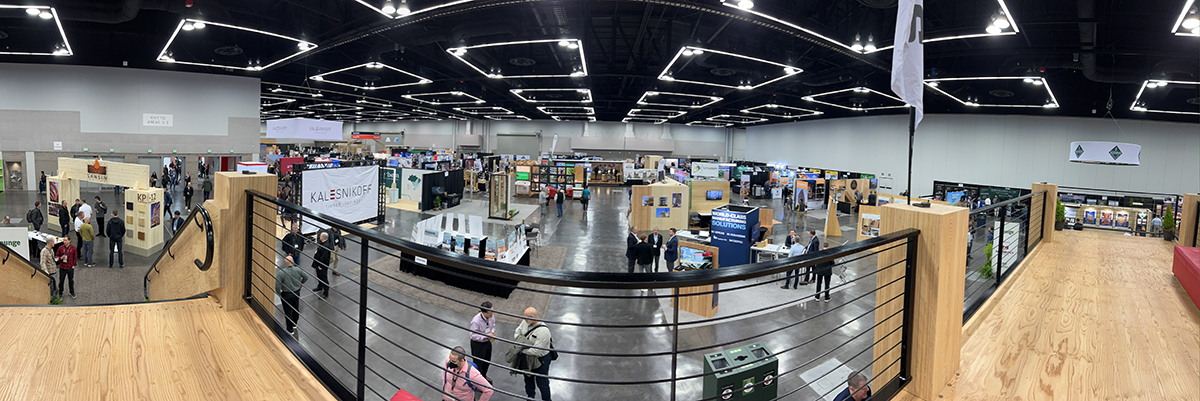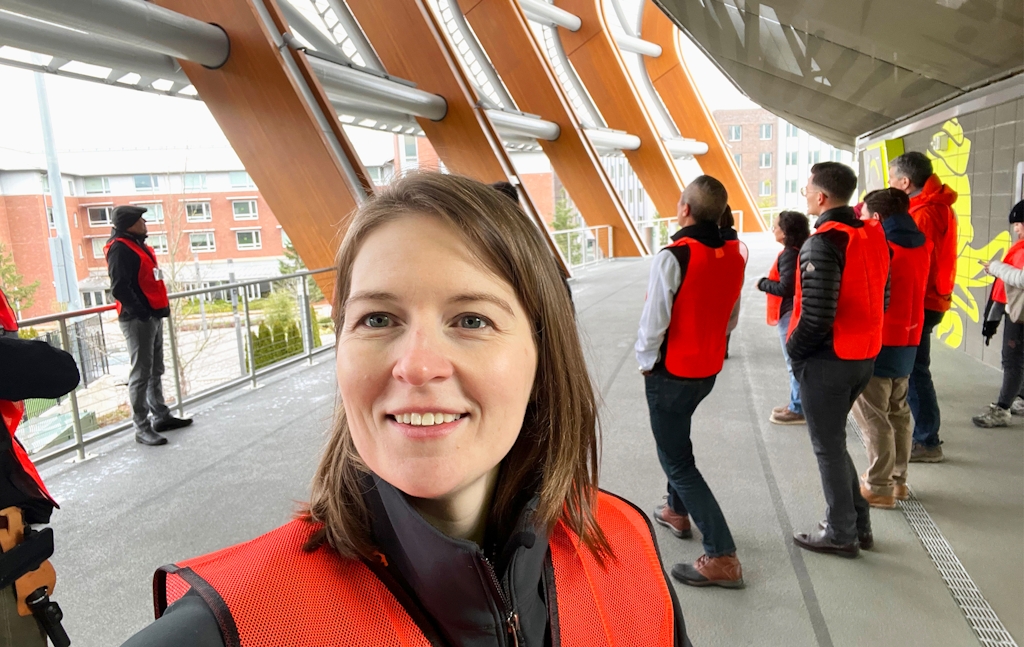In March 2023, I joined attendees from nearly 40 countries to immerse myself in all-things mass timber at the International Mass Timber Conference in Portland, Oregon. The momentum of the mass timber movement was palpable, and I left energized, hopeful, and genuinely excited.
This conference has grown since its inception in 2016 with 500 attendees to more than 3,000 attendees this year. It’s a mark of the rising interest in this biobased building material. Concern about sustainability is far from an afterthought these days—it is driving demand—and there were multiple sessions on that topic, from calculating the carbon footprint of building materials to the sustainability of the wood supply for mass timber.

Mass timber exhibit hall/Jen Shakun
My week began with visits to innovative timber structures and a local, family-owned glulam manufacturer; it was filled with informative presentations and opportunities to interact with colleagues new and old. The exhibit hall featured tangible examples of different mass timber products, including several small structures erected right in the hall. How often are you greeted with the wonderful, earthy smell of wood when you walk into a conference expo?
I also met fellow forest-sector folks at this building-sector conference, including a woman from the Yakama Nation who sees mass timber as a market for wood harvested from wildfire fuel treatments, a friend and colleague from the Georgia Forestry Foundation, and partners from the like-minded nonprofit Sustainable Northwest.
NEFF’s foundational forestry work and our efforts to build a broad coalition around locally grown, sustainable mass timber are why I was invited to speak on a panel about strategies for boosting mass timber’s growth. My fellow panelists talked about financing for manufacturing facilities, opportunities to monetize the carbon stored in structures, and government-led incentive programs. I made the case that building a community of support along the entire supply chain and linking mass timber buildings with climate-smart forestry are key to accelerating the use of mass timber. The session was packed, with a large contingent viewing from an overflow room.
It was another opportunity to describe the holistic, systems approach to forest-based climate solutions NEFF has been promoting for several years. And the message really resonated with people, as evidenced by the number of folks who came up to me after the presentation and in the ensuing days, even in the elevator on my way down to breakfast the following morning.
The concept of a systems approach is starting to click, and our new Climate-Smart Commodities project is an example of how NEFF can pilot this vision on a regional scale. The program will help New England forest landowners implement climate-smart forest practices and build regional markets for climate-smart forest products, with a focus on using mass timber in affordable housing. Ours is one of a handful of forest-focused USDA Climate-Smart Commodities Partnership awards, a point that touches on another takeaway—we are not alone in this.
We are joined by organizations throughout the country who are also thinking deeply about how we can build a truly sustainable and climate-friendly supply chain for this mass-timber building boom we would all like to see happen. This kind of thinking is part and parcel of the leading idea in sustainability these days—transitioning from a linear take-make-waste economy to a circular, biobased economy.
The Circular, Biobased Economy
A circular economy is one in which materials and products are kept at their highest and best use for as long as possible with little waste generation via several strategies, including efficient design and manufacturing processes, sharing or reuse, as well as refurbishing, repairing, and remanufacturing to extend the lifespan of products.
Once they reach the end of their usable life, component materials are recycled or broken down through composting and other processes. A bioeconomy is one that runs on materials and services derived from renewable biological resources like plants. As noted in a recent publication from the Congressional Research Service, “Some predict that the future economy will be primarily a bioeconomy. According to the McKinsey Global Institute (MGI), ‘as much as 60 percent of the physical inputs to the global economy could, in principle, be produced biologically.’”*
Taken together, these concepts of circularity and using biobased materials form the foundation of a lasting solution to many societal challenges. Mass timber is an exciting focal point because it is such a great fit for a circular bioeconomy—a natural material that can be designed for disassembly, as well as recycled and biodegraded.
NEFF has also taken on this mantle with our new Bioeconomy Initiative, which includes all our work to accelerate the thoughtful use of wood products, including mass timber, as part of a regional bioeconomy sourced from—and in support of—excellent forest management. It’s worth noting that some of the terminology is new, but the basic principles are old as dirt. Think of the adage, “waste not want not”—we place a high value on our forests, and rightly so. Let’s see the resources they produce for us used efficiently, judiciously, and for the maximum benefit of people and the environment.


